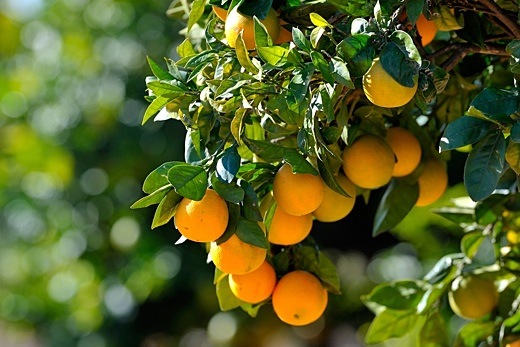SUBHEAD: As pesticides fail, California citrus growers are turning to natural solutions.
By Staff on 9 August 2013 for Eco Watch -
(http://ecowatch.com/2013/pesticides-fail-california-citrus/)

Image above: Oranges on tree. From (http://www.shutterstock.com/cat.mhtml?lang=en&search_source=search_form&version=llv1&anyorall=all&safesearch=1&searchterm=citrus+trees&search_group=#id=85693048&src=VkZljmHfczJX4feTv_j6Pw-1-29).
Citrus growers in California are now turning to a natural solution after pesticides have been shown to be ineffective. Teams of invasive species experts have started releasing tamarixia radiate, a tiny parasitic wasp, to control the invasive Asian citrus psyllid population. Asian citrus psyllid can spread a disease which causes greening, devastating citrus production. This use of biological pest control demonstrates that the use of toxic chemicals is unnecessary as safer alternatives have already been proven effective.
California’s citrus production is a $2 billion industry, which accounts for 80 percent of the U.S. fresh market produce and after Asian citrus psyllid was detected in southern California in 2010 growers have spent close to $15 million annually to fight this pest. The psyllids were first discovered in Florida in 1998 and has since spread to all of its 32 citrus growing counties.
The U.S. Department of Agriculture (USDA) has quarantined nine states, including California and Florida. The quarantines prohibit interstate movement of citrus trees and require labeling of citrus nursery stocks from areas where greening has been detected.
The psyllids cause greening by spreading a disease known as Huanglongbing (HLB) to citrus trees. A pysllid that is infected with HLB can transfer the bacterium every time it feeds on the tree. Once a tree is infected with the disease there is no known cure. HLB is one of the most severe plant diseases in the world and can affect any variety of citrus trees. The disease can lie dormant for several years before tests are able to detect it.
In California, the disease was first detected in November 2012 and has only been found in nine counties that are south of the commercial growing areas, but because of this dormancy California commercial operations may already be infected. After trees become infected fruit from these trees is not suitable for consumer markets because of its green color, misshapen appearance and distinctly bitter taste.
Since 2011, teams of invasive species experts have released more than 75,000 tamarixia wasps across southern California to combat the pysllids. In 2012, agricultural officials halted pesticide spraying in Los Angeles County because it proved ineffective. Six out of 10 trees in the county grow in backyards which if pesticides were used could lead to high levels of pesticide exposure for urban environments. To curb pysllids, teams of invasive species experts have been going to individual homes, releasing the wasps and tracking the parasites success.
The wasps are imported from Pakistan’s Punjab region and extensive tests were conducted to make sure that the wasp would not disrupt other California species or become yet another invasive species. The wasps curb pysllid populations by wasps laying eggs inside the psyllid nymph’s stomach. As the eggs hatch, larvae slowly eats away at the nymph. The teams hope that after the wasps hatch they will fly to neighboring trees and lay eggs in new nymphs and establish a growing population.
Even though the team is only about a year and a half into this effort, at some release sites the population of psyllids has dramatically declined. Mark Hoodle, Ph.D., an invasive species expert at University of California Riverside, said to the Los Angeles Times, “We have no other choice except to use this natural enemy or do nothing. And the ‘do nothing’ option is unacceptable.”
Beyond this recent use of tramarixia wasp, there are many other examples of effective pest management through biological controls. Last summer, several counties in New Jersey used crustaceans, which are voracious predators of mosquito larvae, to control West Nile Virus. The most effective copepod species have the capacity to kill more than 40 mosquito larvae per copepod per day, typically reduce mosquito production by 99-100 percent, and can maintain large populations so long as there is a reliable water source.
A report in 2007 found that Muscidifurax raptor, another parasitic wasp, was effective in controlling fruit flies in vineyards. Goats have also been used across the country to weed airports, cemeteries and to restore soil and improve land quality. The uses of biological controls are important because they prove there are alternatives to toxic pest management.
Farm operations that are USDA certified organic already avoid the use of toxic chemicals by implementing organic systems plans that can include biological pest management. Beyond Pesticides’ Keeping Organic Strong page provides information on the practices and management strategies of organic agriculture.
.
No comments :
Post a Comment